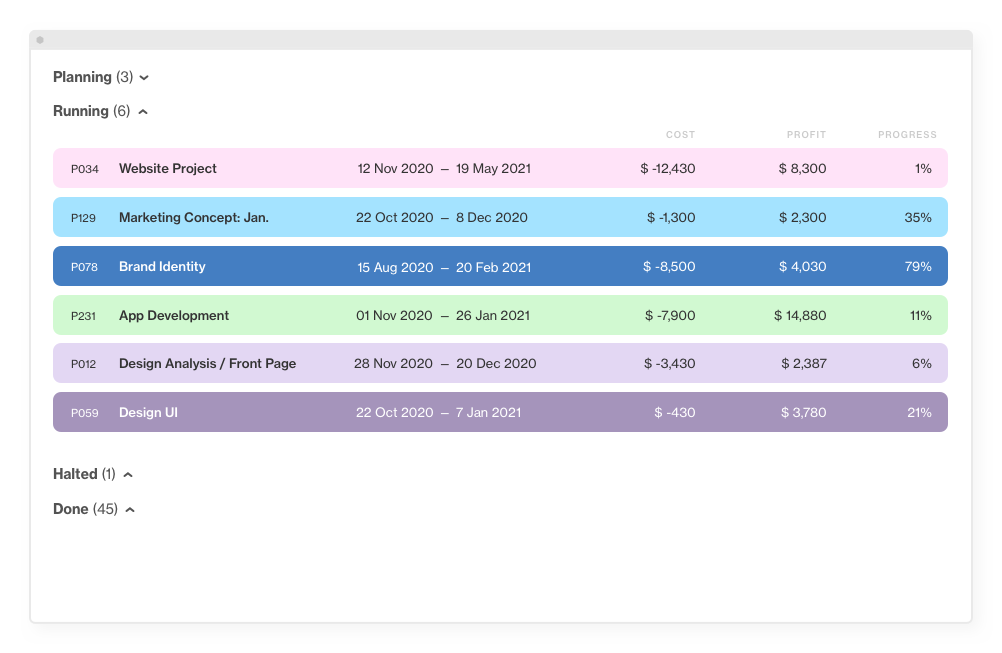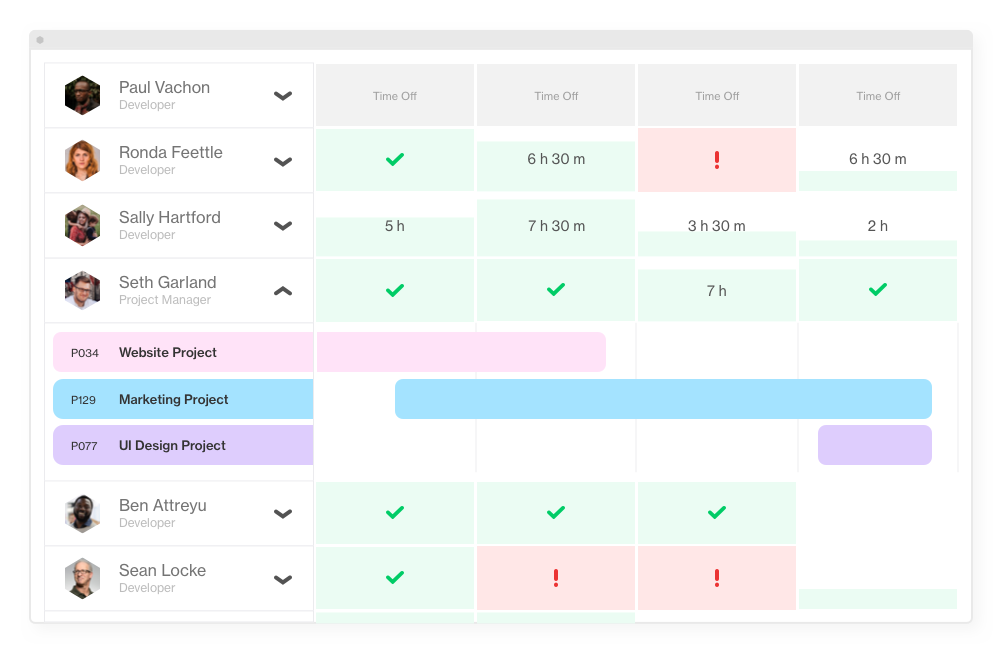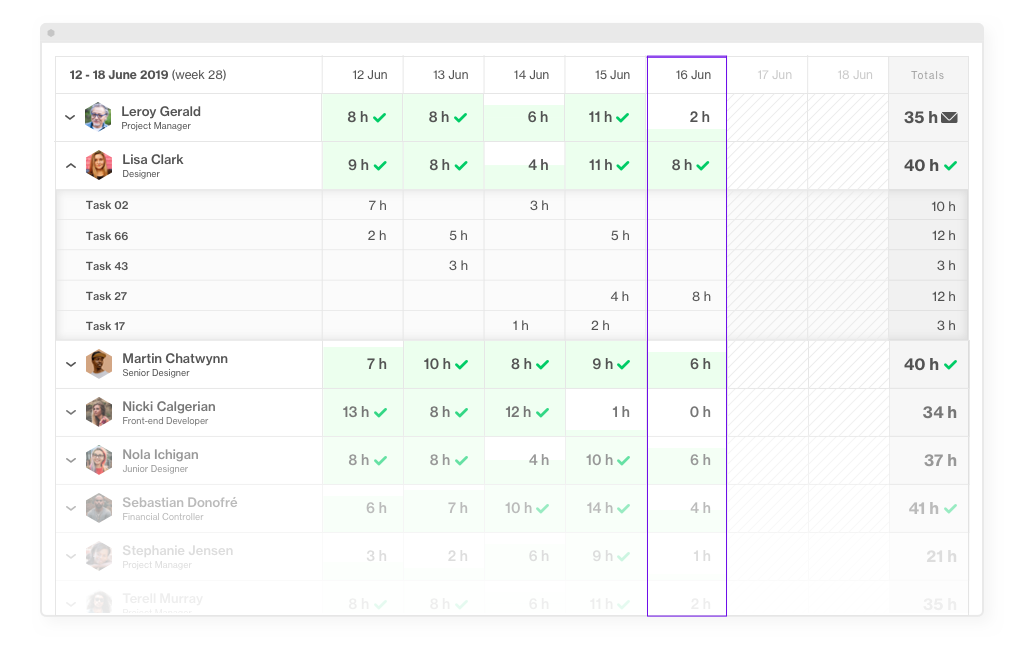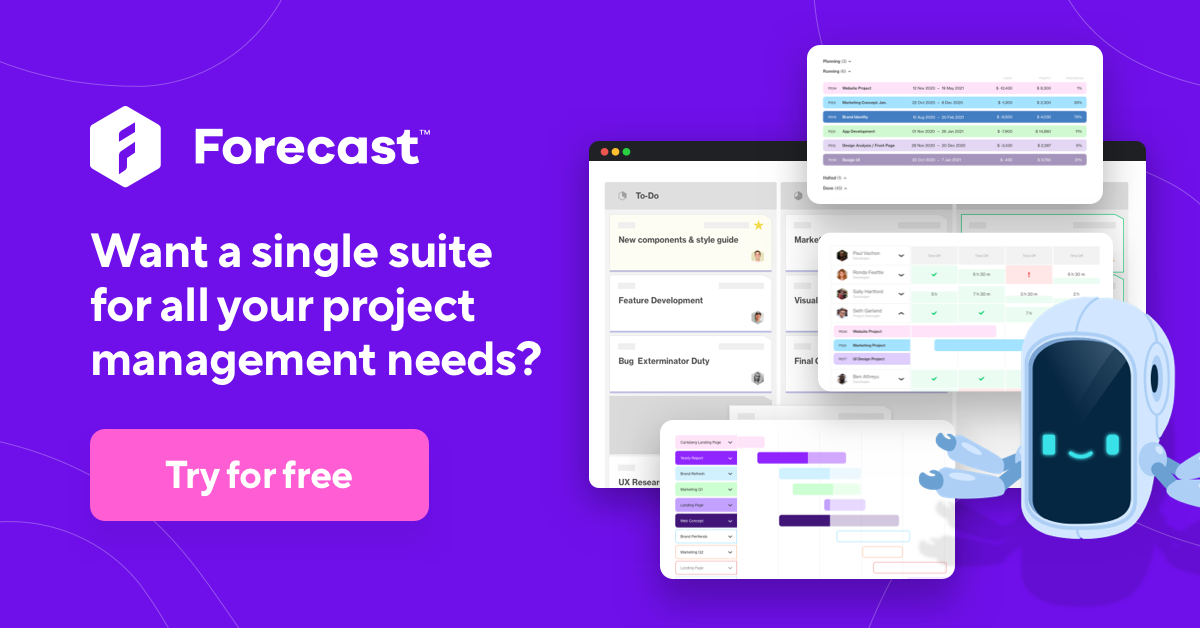The Buyer’s Guide to Project Management Software

Businesses have never had as many options for project management software as they do today. There are literally hundreds of tools that fall in this category, all vying for your attention. In fact, you probably use one or more of them already.
But if project management tools are so abundant and commonly used, why is managing projects still so hard?
The answer is simple: Most ‘project management tools’ are actually designed to manage narrow slices of projects, rather than the whole thing.
They may do a fantastic job managing tasks, but fail to offer any meaningful way of coordinating schedules of the people who will actually be doing those tasks. Or they may build a beautiful Gantt chart, but offer no way to track budget or bill clients for the work that has been done.
This is due in large part to the simple fact that project management software has been around a really long time (Oracle launched theirs in 1977!) and technology has changed a lot since then.
Couple this with the fact that ‘project management software’ is one of the most commonly searched for software categories, incentivizing new market entrants to brand themselves as such even if a much less searched-for term like ‘task management’ would actually be more appropriate, and it becomes clear why it’s so difficult to find the right tools.
This guide examines the most common problems professional services businesses are trying to solve with project management software and suggests a direction to move when selecting the right platform. Continue reading below, or download the ebook if you're on the go: 
- Why Project Management Software, Why Now
- What to Look for in a Project Management Software Vendor
- Automation is Not a Luxury Anymore, It’s a Necessity
- AI-Native: The Next Generation of Project Management Software
- AI-Native vs. Classic Project Management Software
- Why Businesses Choose Forecast Project Management
Why Project Management Software, Why Now
The use of project management software has always been linked to high-performing projects.
95% of organizations, happy with their projects, use project management software as a conduit for productivity and growth.
Employed for project planning, time management, resource allocation, change management, team collaboration, financial reporting, and other key business functions, it is among the most useful tools that can help professional services companies organize forces to become as competitive as possible.

In fact, by investing in proven project management practices, businesses can save 28 times more money as their output becomes more reliable.
But not only that. Project management software can help businesses solve other top rising challenges.
To finally create an efficient resource strategy
Project and operation managers still fail on many fronts when it comes to resourcing people onto projects and making smart hiring decisions.
In fact, poor resource management has seen the largest increase since 2018 and is now ranked as the 2nd top challenge to companies across different industry sectors in the United Kingdom and internationally, remarks Vince Hines, a Managing Director at Wellingtone. At the same time, 67% of CEOs do not know if they need to hire or fire 3-4 months from now.
As clients demand greater value and flexibility at lower prices, companies need to learn how to use their resources efficiently without leaving anyone to sit on the bench or overworking staff.
Project management software with a real-time overview of the entire portfolio of resources could not only give you a snapshot of who’s fully booked with work or underallocated, but also inform your hiring decisions by answering the following questions:
- Is there a person available for the date required by the client?
- Where can I adjust to meet the deadline?
- Can my schedule squeeze in another project?

If you are resource-strapped and there’s no holistic overview of who’s doing what, project management software will help you introduce clarity into your capacity, among other benefits.
To stop data sprawl
Professional services businesses, large and small, unquestionably juggle numerous projects, plans, tasks, and people.
At the same time, every project requires ongoing documentation, which means the vast amount of data the business produces needs to be captured and stored somewhere. Typically, there are various data streams siloed per department or branch, leading to information scattered across multiple endpoints.
As a result, as companies grow, they tend to generate more data than they can keep up with, getting to the point of ‘data sprawl,’ a phenomenon that stands for the staggering amount of data produced by businesses every day.
Businesses are drowning in complications; and as they lack foresight and are staying in the dark regarding the data they produce, it’s becoming more difficult to retain their positions in the industry.
Unable to glean data from previous projects, businesses can't make better offerings, and therefore keep losing piece after piece of the market pie. Setting a strong technological foundation in place (more on that later), the industry can finally get hold of data and unlock actionable business insights.
To break the cycle of over-servicing clients
Project scope is never set in stone. It doesn’t matter how detailed your proposal initially was, the clients will start changing the game. Because client requirements change all the time, it’s very easy to lose track of the budget against deliverables. Sadly, 54% of Chief Operating Officers admit that one of their biggest challenges is that of providing more value at the same cost.
Over-servicing clients will stay put and impact profitability significantly unless you invest in proper time management. Even a tiny bit of scope creep can turn into a significant amount of non-billable time and cut into your margin if you’re not careful. The truth is, you won’t know how much extra work you’re doing if you don’t track your time.

To keep costs low, defining deliverables upfront is not enough. Tapping into your time tracking when work is in progress and communicating just in time makes a world of difference. “It’s pretty easy to show your boss that everyone on your team is 110 percent utilized. That’s a pretty strong signal that you need more help,” points out Gini Dietrich, the founder, CEO, and author of Spin Sucks.
To aim higher than another spreadsheet
Even though they were never meant to manage projects, spreadsheets are still widely used for resource and project management purposes. They might work fine during the initial months or years of a company’s life, but as it grows, this exercise turns into a battle with a mishmash of data that nobody likes to deal with. That’s because spreadsheets are missing on a number of fronts:
- Limited functionality and usability
- Collaboration is not in the nature of spreadsheets
- Project data is not always up-to-date
- Constant maintenance of custom spreadsheets eats up valuable time
Otherwise, it’s often generally just a hassle to keep everybody up-to-date through a shared document. Think for a moment, can spreadsheets answer questions like ‘what’s the current status of the project?’ ‘what’s the operating margin?’ or ‘how profitable are the projects?

They can’t, because there are only a few things a spreadsheet can automate. Thus, when a spreadsheet becomes your barrier to getting things done or moving to the heart of the problem quickly, you should think of another way to do work through which your personal and everyone else’s KPIs could be improved.
That’s why we’re fond of a more centralized approach, in the sense that your data, communication, and assets are collected and managed from the same interface across the organization. Besides that, finding a software vendor that suits all of your needs is essential.
What to Look for in a Project Management Software Vendor
Project management software can become a major game-changer for your project operations. It can eliminate a great deal of manual work, helping you make more accurate estimations, stop stretching your resources, and put an end to over-servicing clients. However, there are a few other important things you can evaluate before making the final decision.
1) Built by industry veterans
Vendors that have gained experience over the years are more likely to know which features exactly you need to improve operations and deliver successful projects. They also know the ins and outs of project management and can provide you with proper onboarding and consulting services when it comes to a specific problem you want solved. Educated account representatives and customer success managers are a sign that you won’t be left in deep waters when somebody throws a spanner in your work.
2) Supports the way you work
The ideal project management software will not only have to tick all your boxes in terms of features you’ve pencilled in. It will have to fit in the way that you do business and support your decisions to stick to established structures, at the same time advising where those could be improved in the current setup.
- If yours is an agile organization, make sure the vendor provides sprint or kanban features for letting your culture thrive.
- If you’re practicing waterfall, look out for functionality that keeps you up-to-date on progress and automates administrative tasks, such as re-planning or financial reporting.
- If you’re running projects on a retainer basis, look for solutions that would click with retainer contracts and ongoing work.
- Regardless of the methodology you use, look out for resource management functionality, as it will cater to the need of doing intelligent capacity planning.
That being said, when choosing a platform, set a bar for holistic project management and a vendor that cares about your interests to be flexible whenever you want to introduce the change. The software should be your 'project command center' where you handle all aspects of the project, not just a narrow slice.
3) Reliable integrations with other tools
It’s a given that different departments use different tools. Without turnkey integrations, vendors can lock you in and hinder transparency, creating walls between your employees and make it difficult to follow everyone else’s progress and work towards the same goal. In fact, businesses that are not seamlessly integrated often have significant cost escalation and unstable resource utilization.

Integrations help you tear down the silos and bridge the gap between multiple business functions that pays off in improved cross-departmental collaboration and improved data accessibility. You’re looking for a one-stop shop rather than another point solution that lacks overview and connection with the rest of the organization. Vendors that care about the future of work are mindful about systems playing nicely together.
4) Ability to scale as your company grows
In this kind of relationship, growth can’t happen only at one side of the riverbank. Make your vendor’s growth a priority and be certain they can follow through and deliver the same quality with the same speed. To know if you and your vendor are at the same wavelength, ask for the vendor’s roadmap. This will help you understand what’s on their radar and if you are moving in the same direction. Better still, vendors should always be one step ahead of you, treading the path for growth.
Automation is Not a Luxury Anymore, It’s a Necessity
In a survey by KRC Research, nearly 80 percent of executives polled agreed that each of them could save 360 hours a year through automation. A lot of time goes to waste simply because too much of the administrative clerical work is sitting on their desks.
As a matter of fact, 36% of respondents to the annual report State of Project Management claim that it takes them 4 hours to 1 day to collate project status info every month. At the same time, 21% of project managers admit spending more than 2 days per month on it.
This might come as a surprise, but almost every core business process that’s repeatable can be automated, from quote to invoice, starting from project planning and proposal development to knowledge sharing and financial reporting, you name it. So the question is not whether you should automate but what and where you should automate.
Project management software is designed to weed out work-intensive processes and reduce unnecessary data entry points. This is done through automating different time-consuming processes, such as project planning and scheduling, financial reporting, workflow management.
At the end of the day, it helps to get more out of doing less. The benefits of automation will not be long in coming - you’ll start seeing them immediately to then realize how much time you’re saving without having to spend hours crunching numbers or doing other administrative tasks. In fact, project management software makes automation scalable across all projects and teams, it’s not a one-and-done initiative.
AI-Native: The Next Generation of Project Management Software
63% of executives believe project complexity is the number one top operational challenge expected in the next five years. With data flooding in, it’s difficult to make right business decisions at any touchpoint of the business - the reason being the global nature of the industry (project overseas) and a complex macro-environment.
Artificial intelligence (AI) in the center of automation is the glue that holds everything together and helps you make better use of all your data. Gartner anticipates that artificial intelligence will eliminate 80% of today’s manual project management tasks by 2030. This will be achieved by AI-native project management software penetrating the market and becoming the new normal as opposed to traditional project management tools.
AI-Native vs. Classic Project Management Software
Take a look at the advantages AI provides over classic project management tools! You’ll be surprised how some of the project management software vendors have moved the needle for companies fighting with data.
|
AI-Native |
Classic |
|
Centralizes all project data for AI modeling |
Collects and stores project data |
|
Predicts project delivery dates based on past data |
Shows the list of tasks for project managers to predict the delivery date, based on the critical path |
|
Minimizes risk by assessing upcoming issues and suggesting solutions |
Misses connection between time registrations and budget, keeping everyone in the dark regarding risks and the project’s progress |
|
Automatically allocates tasks to the right people |
Does not accommodate resourcing features, forcing project managers to nag team members and find people available to work on the tasks |
|
Reduces schedule variance by assisting with more accurate estimations than a human can come up with |
Lacks planned vs. actual metrics to track project progress |
|
Provides AI-driven suggestions to make time registrations more accurate |
Provides outdated tools for registering time that take time away from the actual project, increasing admin work and human error |
|
Forecasts project profit months in advance |
Lacks financial insights, focusing more on managing tasks rather than people and finances |
|
Re-plans the project scope in seconds in a simulation whenever a new client request appears |
Requires manual re-planning on a daily basis and takes away actual time from more important commitments |
Read on: How Forecast Uses AI to Assist Your Projects
Why Businesses Choose Forecast Project Management
Forecast is a holistic project and resource management platform leveraging AI to improve operational and financial performance. Forecast has learned from more than 50,000 projects and helped estimate more than a million tasks. What makes the platform stand out is a set of algorithms that can learn and adjust for the future. But its main benefit is connecting all the bits and pieces of functionalities into one unified solution to plan, budget, run, and track projects. All in all, you can manage a project from start to finish, having AI at hand helping you become more accurate and precise with your project forecast and plan projects twice as fast. In essence, Forecast uses everything that might be useful to improve your personal algorithm.
But don’t take our word for it. Checkout how our customers use Forecast daily to improve their project operations, or try it today.
You might like to read these articles on our blog..
Subscribe to the Forecast Newsletter
Get a monthly roundup of productivity tips & hacks delivered straight to your inbox


